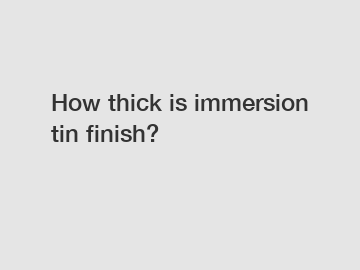How thick is immersion tin finish?
How thick is immersion tin finish?
In the world of electronics manufacturing, surface finishes play a crucial role in ensuring the functionality and longevity of printed circuit boards (PCBs). These finishes protect the copper traces on PCBs from oxidation and provide a solderable surface for component placement. One popular surface finish is immersion tin, known for its flatness, solderability, and cost-effectiveness. However, one question that often arises is: How thick is immersion tin finish? In this article, we will delve into the specifics of immersion tin thickness, its importance, the factors that affect it, and its advantages and limitations.
1. Why is immersion tin thickness important?

The thickness of immersion tin coating is critical to ensure proper solderability and the overall performance of the PCB. If the tin coating is too thin, it may not provide sufficient protection against oxidation, leading to reliability issues over time. On the other hand, if the coating is too thick, it can create an uneven surface, potentially impacting the assembly process and causing solderability problems.
2. What is the typical immersion tin thickness?
The thickness of immersion tin finish typically ranges from 0.8 to 1.2 micrometers (µm). This range is considered ideal for most PCB applications, striking a balance between providing reliable protection against oxidation and maintaining good solderability. It is crucial to ensure that the thickness remains within this range during the PCB manufacturing process.
3. Factors influencing immersion tin thickness.
Several factors influence the resulting thickness of immersion tin finish on a PCB. The most significant factors include the plating time, tin concentration in the bath, and the temperature of the plating solution. Manufacturers have to carefully control these parameters to achieve the desired thickness and ensure uniform coating across the entire PCB surface.
4. Advantages of immersion tin finish.
Immersion tin offers various advantages, contributing to its popularity as a surface finish option. Firstly, it provides a flat surface, which is beneficial for the placement of surface-mounted components. Immersion tin also offers excellent solderability, ensuring strong and reliable joints during the assembly process. Additionally, the immersion tin finish is cost-effective compared to other surface finishes like gold or silver, making it an attractive choice for many applications.
5. Limitations of immersion tin finish.
While immersion tin has its advantages, it also has certain limitations that need to be considered. One limitation is its susceptibility to oxidation during storage or in humid environments. This vulnerability to oxidation necessitates the proper handling of PCBs with immersion tin finish to maintain their reliability. Moreover, immersion tin finish may not be suitable for applications with high operating temperatures, as tin has a relatively low melting point compared to other surface finishes.
In conclusion, immersion tin finish on PCBs is typically 0.8 to 1.2 micrometers thick, striking a delicate balance between protection against oxidation and ensuring good solderability. The thickness is critical for the performance and reliability of the boards. Control over factors like plating time, bath concentration, and temperature is necessary to achieve the desired results. While immersion tin has advantages such as flatness, good solderability, and cost-effectiveness, its susceptibility to oxidation and limited suitability for high-temperature applications make it necessary to consider alternatives in some cases. By understanding the importance and limitations of immersion tin finish, manufacturers can make informed decisions regarding the appropriate surface finish for their specific PCB requirements.
For more automotive pcb design , hasl lead free, Industrial Control PCB Manufacturerinformation, please contact us. We will provide professional answers.


